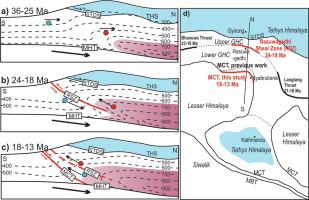当前位置:
X-MOL 学术
›
J. Asian Earth Sci.
›
论文详情
Our official English website, www.x-mol.net, welcomes your
feedback! (Note: you will need to create a separate account there.)
In-sequence buoyancy extrusion of the Himalayan Metamorphic Core, central Nepal: Constraints from monazite petrochronology and thermobarometry
Journal of Asian Earth Sciences ( IF 2.7 ) Pub Date : 2020-09-01 , DOI: 10.1016/j.jseaes.2020.104406 Gautam Prashad Khanal , Jia-Min Wang , Fu-Yuan Wu , Jian-Gang Wang , Lei Yang
Journal of Asian Earth Sciences ( IF 2.7 ) Pub Date : 2020-09-01 , DOI: 10.1016/j.jseaes.2020.104406 Gautam Prashad Khanal , Jia-Min Wang , Fu-Yuan Wu , Jian-Gang Wang , Lei Yang

|
Abstract Recent identification of tectono-metamorphic discontinuities within the Himalayan metamorphic core has challenged previous understanding of mountain-building processes/models during continental collision. However, their exact position, spatial extent, and temporal evolution still remain in debate. Monazite petrochronology and thermobarometry have been applied to metapelites of the Gyirong-Syabrubensi-Langtang transect in central Nepal. Peak metamorphic temperatures and pressures were determined by conventional thermobarometry and Zr-in Rutile thermometry. P-T conditions increase structurally upward from 540–580 °C, 8–10 kbar at LHS to 640–710 °C, 8–12 kbar at lower GHC, and 680–720 °C, 6–9 kbar at upper GHC. Petrochronology studies indicate prograde metamorphism in the LHS, partial melting of 20–18 Ma in the lower GHC and prolonged partial melting at 29–23 Ma in the upper GHC, demonstrating a diachronism across these units. The Rasuwagadhi Shear Zone (RSZ), is marked by a jump in T/depth and peak metamorphic timing from lower GHC ( 30 °C/km, ~29 Ma), and can be correlated with the regional High Himalayan Discontinuity recently identified within the GHC in other Himalayan transects. This shear zone acted almost synchronously with the South Tibetan Detachment around 24–18 Ma and was relayed by movement along the Main Central Thrust after 18 Ma, presenting south-ward in-sequence thrust propagation style. Therefore, a hybrid model, In-sequence Buoyancy Extrusion that involves a combination of underplating and buoyancy mechanisms is proposed to explain the overall exhumation of HMC, and perhaps is applicable to metamorphic core in similar large and hot collisional orogen.
中文翻译:

尼泊尔中部喜马拉雅变质岩核的连续浮力挤压:独居石年代学和热气压测量法的限制
摘要 最近对喜马拉雅变质核心内构造-变质不连续性的识别挑战了先前对大陆碰撞期间造山过程/模型的理解。然而,它们的确切位置、空间范围和时间演变仍然存在争议。独居石年代学和热气压法已应用于尼泊尔中部吉隆-Syabrubensi-Langtang 断面的变泥质岩。峰值变质温度和压力通过常规热气压法和 Zr-in Rutile 温度法测定。PT 条件在结构上从 LHS 的 540–580 °C、8–10 kbar 上升到 640–710 °C、较低 GHC 的 8–12 kbar 和 680–720 °C、较高 GHC 的 6–9 kbar。岩石年代学研究表明 LHS 存在顺行变质作用,下部 GHC 中 20-18 Ma 的部分熔化和上部 GHC 中 29-23 Ma 的部分熔化延长,表明这些单元的历时性。Rasuwagadhi 剪切带 (RSZ) 的特点是 T/深度和峰值变质时间从较低的 GHC(30 °C/km,~29 Ma)跳跃,并且可以与最近在该区域内发现的区域高喜马拉雅不连续性相关其他喜马拉雅横断面的 GHC。该剪切带在24~18 Ma前后几乎与藏南拆解同步作用,18 Ma后沿主中央冲断层运动转播,呈现向南依次逆冲传播方式。因此,提出了一种混合模型,即包含底板和浮力机制组合的顺序浮力挤压来解释 HMC 的整体折返,
更新日期:2020-09-01
中文翻译:

尼泊尔中部喜马拉雅变质岩核的连续浮力挤压:独居石年代学和热气压测量法的限制
摘要 最近对喜马拉雅变质核心内构造-变质不连续性的识别挑战了先前对大陆碰撞期间造山过程/模型的理解。然而,它们的确切位置、空间范围和时间演变仍然存在争议。独居石年代学和热气压法已应用于尼泊尔中部吉隆-Syabrubensi-Langtang 断面的变泥质岩。峰值变质温度和压力通过常规热气压法和 Zr-in Rutile 温度法测定。PT 条件在结构上从 LHS 的 540–580 °C、8–10 kbar 上升到 640–710 °C、较低 GHC 的 8–12 kbar 和 680–720 °C、较高 GHC 的 6–9 kbar。岩石年代学研究表明 LHS 存在顺行变质作用,下部 GHC 中 20-18 Ma 的部分熔化和上部 GHC 中 29-23 Ma 的部分熔化延长,表明这些单元的历时性。Rasuwagadhi 剪切带 (RSZ) 的特点是 T/深度和峰值变质时间从较低的 GHC(30 °C/km,~29 Ma)跳跃,并且可以与最近在该区域内发现的区域高喜马拉雅不连续性相关其他喜马拉雅横断面的 GHC。该剪切带在24~18 Ma前后几乎与藏南拆解同步作用,18 Ma后沿主中央冲断层运动转播,呈现向南依次逆冲传播方式。因此,提出了一种混合模型,即包含底板和浮力机制组合的顺序浮力挤压来解释 HMC 的整体折返,











































 京公网安备 11010802027423号
京公网安备 11010802027423号